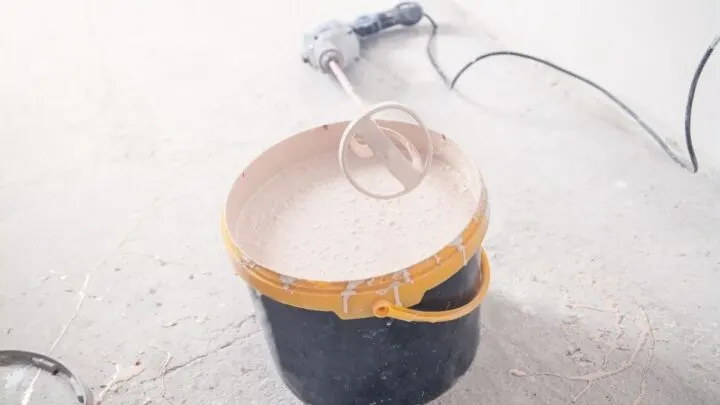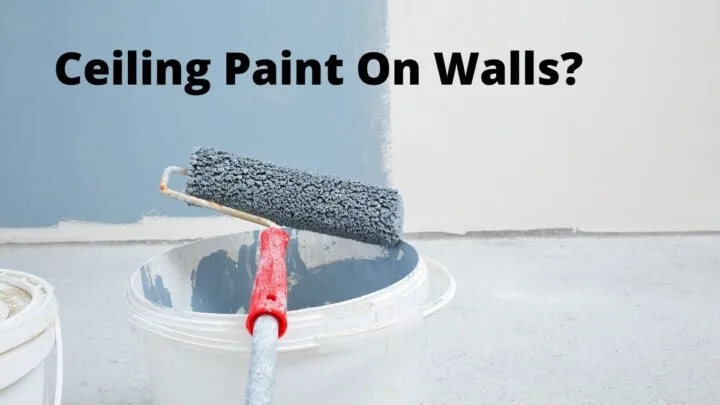Can a single can of paint go from ceiling to wall? Many people wonder if ceiling paint can be used on walls to create a uniform look when painting.
Ceiling paint is not commonly used on walls due to its limited color selection, flat appearance, and high viscosity. However, it is sometimes used in areas such as stairwells, closets, playrooms, or finished basements where a refined finish is less important.
Some scenarios are actually great for using ceiling paint on a wall. However, it’s important to know the rules of using ceiling paint on other surfaces before dipping that roller!
Here’s what else I’ll be covering in this article:
Table of Contents
Differences Between Ceiling and Wall Paint
What makes ceiling paint different from wall paint?
The quick answer is that ceiling paint is flat. While there are plenty of flat wall paints on the market, ceiling paint really takes the concept of hiding blemishes to the next level.
Ceiling paint doesn’t reflect light. This is what makes it so great at hiding imperfections along the edges of a room. It’s amazing for “evening out” walls that are full of blemishes, bumps, and marks.
Ceiling paint has a higher viscosity than wall paint. Viscosity can be thought of as a paint’s “thickness” level.
High viscosity helps paint to stay on the ceiling instead of dripping when it’s being applied.
Ceiling paint’s thickness allows it to stick better to surfaces while being rolled on. Dripping is one of the big reasons why wall paint can’t be applied to ceilings.
It’s simply too thin and watery to stay on the ceiling without splatters of color raining downs!
Viscosity isn’t just important during application. The higher viscosity also helps to make ceiling paint more durable when it comes to resisting marks, bumps, and dings once the paint is dry.
The big benefit of using ceiling paint on walls is that repainting isn’t required as often.
Ceiling paint creates a nice “seal” that protects walls from the marks that occur so easily with ordinary ceiling paint!
Another perk of ceiling paint is that one layer goes a lot farther than one layer of wall paint. It’s easy to get away with one coat instead of going back for a second or third coat to get a good finish. A single-coat paint job with wall paint is essentially impossible.
Ceiling paint does have some downsides. First, its flat finish can look less than appealing in some rooms.
Ceiling paint also comes in just a fraction of the colors of wall paint.
Another disadvantage of ceiling paint versus wall paint is that wall paints come in specialty formulations for spots like kitchens, bathrooms, and mudrooms that resist water, mildew, and mold.
While wall paints are designed to stand up to gentle scrubbing with soap and water, ceiling paint is designed to be “dusted” instead of scrubbed.

Best Scenarios to Use Ceiling Paint on Walls
It’s possible to use ceiling paint to create a cozier aesthetic in a room by “sealing in” the room with one color. This is commonly done by home designers looking to marry high vaulted ceilings with walls in a large room for a neater, cozier look.
Using ceiling paint on a wall is sometimes just a matter of convenience over style. For example, painting closets with ceiling paint can be an easy way to avoid the hassles of taping when doing a new build or renovation.
Stairwells are also prime spots for ceiling paint because durable ceiling paint can hide dirt, scuffs, and imperfections while protecting this high-traffic area against new markings.
Ceiling paint can also work in a room where messes are bound to happen. For instance, a playroom or finished basement could work nicely with ceiling paint used as wall paint simply because the room can be repainted over and over again without the need to apply several layers of primer and paint.
One coat of ceiling paint over the existing ceiling paint every few years may be enough to keep a frills-free room fresh without the need to cry every time someone drags a marker across a wall!
One key takeaway should be that the limited variety of colors for ceiling paint can make it hard to use ceiling paint as a substitute for wall paint.
Ceiling paint can easily be swapped for wall paint when the objective is an all-white room where light doesn’t bounce around.
The good news is that some paint brands are starting to branch out with more ceiling colors. It’s sometimes possible to mix two shades of ceiling paint together to get a custom color for walls.
Can You use Ceiling Paint as an Undercoat (Primer) on Walls?
Yes! Using ceiling paint as a primer is actually the ideal way to use ceiling paint on a wall.
The question comes down to whether this should actually be the first choice when there’s not already a spare can of ceiling paint hanging around.
First, ceiling paint works beautifully as a paint sealant. It’s almost a shame to not use ceiling paint as a primer if you have a leftover bucket.
Ceiling paint isn’t just a great primer for walls. Door and window frames can also take ceiling paint as a primer.

Can You Mix Ceiling Paint With Wall Paint?
There’s no rule against mixing ceiling paint and wall paint. It’s important to make sure the two paint products being mixed are the same paint types. This just means mixing latex with latex instead of mixing latex and oil.
Mixing ceiling paint with wall paint really only works in one direction.
While it may be tempting to mix wall paint into ceiling paint to create a custom color for the ceiling, the low viscosity of wall paint could cause dripping. The final product may not dry properly.
The best way to maximize the perks of both ceiling paint and wall paint is to combine them as an undercoat and topcoat using separate applications.
This provides the efficiency and durability of using ceiling paint on the wall while highlighting the beauty of true wall paint.
What Is the Difference Between Flat White Paint and Ceiling Paint?
Ceiling paint isn’t necessarily interchangeable with flat paint. However, almost all ceiling paint is flat paint.
Flat white paint is just paint with a matte, non-reflective surface. It has stronger pigment than other finishes. That means you can’t see through it quite as much when trying to cover up another color that was previously on the wall.
Flat paint is meant to blend into the surroundings instead of drawing attention. Like ceiling paint, flat white paint is incredible for hiding imperfections. Think of it as a “blocking” paint.
Flat paint is the way to go when trying to conceal a wall that’s slightly damaged without actually fixing the damage. This means things like scuff marks, nail marks, and slight indentations.
Flat paint’s ability to absorb light means that attention won’t be called to bumps and indentations even if they’re in plain sight.
A dark paint color with a flat finish can be best for hiding a wall that’s in pretty bad shape!
Like ceiling paint, flat white paint makes a great topcoat. However, the big difference between flat white paint that’s intended for walls and flat ceiling paint is the viscosity level.
Ceiling paint will be less “drippy” than any ordinary flat white paint on the market.
Final Thoughts on Using Ceiling Paint on Walls
It’s fine to use ceiling paint on walls. In some cases, it might be preferred as a cost-saving measure for using leftover white ceiling paint as a primer.
The only thing to keep in mind when using ceiling paint as a top-layer wall paint is that the lack of color variety makes this a hard “first choice.”


